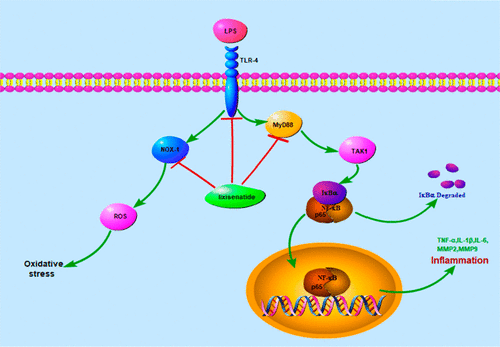当前位置:
X-MOL 学术
›
Chem. Res. Toxicol.
›
论文详情
Our official English website, www.x-mol.net, welcomes your
feedback! (Note: you will need to create a separate account there.)
Protective Effects of Lixisenatide against Lipopolysaccharide-Induced Inflammation Response in MAC-T Bovine Mammary Epithelial Cells: A Therapeutic Implication in Mastitis.
Chemical Research in Toxicology ( IF 3.7 ) Pub Date : 2020-03-19 , DOI: 10.1021/acs.chemrestox.9b00524 Peng Li 1 , Qipeng Liu 1 , Ting Zhang 1 , Wanying Guo 1 , Weiqiang Qiao 1 , Miao Deng 1
Chemical Research in Toxicology ( IF 3.7 ) Pub Date : 2020-03-19 , DOI: 10.1021/acs.chemrestox.9b00524 Peng Li 1 , Qipeng Liu 1 , Ting Zhang 1 , Wanying Guo 1 , Weiqiang Qiao 1 , Miao Deng 1
Affiliation

|
Mastitis is acute inflammation caused by microbial infections in the mammary glands. This disease is extremely harmful to lactating mothers. The preferred clinical strategy is antibiotic treatment, but this method results in resistance and side effects. Lixisenatide, a kind of glucagon-like peptide-1 (GLP-1) receptor agonist, is typically used for the treatment of type II diabetes. It is unknown whether lixisenatide possesses a beneficial role in mastitis. In the current study, we assessed the protective effects of lixisenatide against lipopolysaccharide (LPS) stimulation in MAC-T bovine mammary epithelial cells (MECs). Our findings show that lixisenatide attenuated LPS-induced oxidative stress by reducing reactive oxygen species (ROS) production and nicotinamide adenine dinucleotide phosphate (NADPH) oxidases-1 (NOX-1) expression in MAC-T MECs. Additionally, lixisenatide inhibited LPS-induced expression and secretion of tumor necrosis factor-α (TNF-α), interleukin 6 (IL-6), and interleukin 1β (IL-1β). We also found that lixisenatide suppressed LPS-induced expression of matrix metalloproteinase 2 (MMP-2) and metalloproteinase 9 (MMP-9), and reduced the expression of toll-like receptor 4 (TLR4) (a typical receptor of LPS), its downstream molecule myeloid differentiation factor 88 (MyD88), and the phosphorylation of TGF β-activated kinase 1 (TAK1). Notably, lixisenatide decreased the nuclear levels of nuclear factor-κB (NF-κB) and its transcriptional activity. These findings suggest that lixisenatide might become a possible therapeutic agent for the treatment of mastitis by weakening oxidative stress and the inflammatory response in MECs.
中文翻译:

Lixisenatide对脂多糖诱导的MAC-T牛乳腺上皮细胞炎症反应的保护作用:在乳腺炎中的治疗意义。
乳腺炎是由乳腺中的微生物感染引起的急性炎症。这种疾病对哺乳期母亲极为有害。首选的临床策略是抗生素治疗,但是这种方法会导致耐药性和副作用。利西拉来肽是一种胰高血糖素样肽-1(GLP-1)受体激动剂,通常用于治疗II型糖尿病。未知利西拉来在乳腺炎中是否具有有益作用。在当前的研究中,我们评估了利西拉肽对MAC-T牛乳腺上皮细胞(MEC)中脂多糖(LPS)刺激的保护作用。我们的研究结果表明,利西拉来可以通过降低MAC-T MEC中的活性氧(ROS)产生和烟酰胺腺嘌呤二核苷酸磷酸(NADPH)氧化酶-1(NOX-1)的表达来减轻LPS诱导的氧化应激。此外,利西拉来抑制LPS诱导的肿瘤坏死因子-α(TNF-α),白介素6(IL-6)和白介素1β(IL-1β)的表达和分泌。我们还发现利西拉来抑制LPS诱导的基质金属蛋白酶2(MMP-2)和金属蛋白酶9(MMP-9)的表达,并降低了Toll样受体4(TLR4)(LPS的典型受体)的表达,下游分子髓样分化因子88(MyD88)和TGFβ活化激酶1(TAK1)的磷酸化。值得注意的是,利西拉来降低了核因子-κB(NF-κB)的核水平及其转录活性。这些发现表明,利西拉来可能通过减弱MEC中的氧化应激和炎症反应而成为治疗乳腺炎的可能治疗剂。利西拉来抑制LPS诱导的肿瘤坏死因子-α(TNF-α),白介素6(IL-6)和白介素1β(IL-1β)的表达和分泌。我们还发现利西拉来抑制LPS诱导的基质金属蛋白酶2(MMP-2)和金属蛋白酶9(MMP-9)的表达,并降低了Toll样受体4(TLR4)(LPS的典型受体)的表达,下游分子髓样分化因子88(MyD88)和TGFβ活化激酶1(TAK1)的磷酸化。值得注意的是,利西拉来降低了核因子-κB(NF-κB)的核水平及其转录活性。这些发现表明,利西拉来可能通过减弱MEC中的氧化应激和炎症反应而成为治疗乳腺炎的可能治疗剂。利西拉来抑制LPS诱导的肿瘤坏死因子-α(TNF-α),白介素6(IL-6)和白介素1β(IL-1β)的表达和分泌。我们还发现利西拉来抑制LPS诱导的基质金属蛋白酶2(MMP-2)和金属蛋白酶9(MMP-9)的表达,并降低了Toll样受体4(TLR4)(LPS的典型受体)的表达,下游分子髓样分化因子88(MyD88)和TGFβ活化激酶1(TAK1)的磷酸化。值得注意的是,利西拉来降低了核因子-κB(NF-κB)的核水平及其转录活性。这些发现表明,利西拉来可能通过减弱MEC中的氧化应激和炎症反应而成为治疗乳腺炎的可能治疗剂。白介素6(IL-6)和白介素1β(IL-1β)。我们还发现利西拉来抑制LPS诱导的基质金属蛋白酶2(MMP-2)和金属蛋白酶9(MMP-9)的表达,并降低了Toll样受体4(TLR4)(LPS的典型受体)的表达,下游分子髓样分化因子88(MyD88)和TGFβ活化激酶1(TAK1)的磷酸化。值得注意的是,利西拉来降低了核因子-κB(NF-κB)的核水平及其转录活性。这些发现表明,利西拉来可能通过减弱MEC中的氧化应激和炎症反应而成为治疗乳腺炎的可能治疗剂。白介素6(IL-6)和白介素1β(IL-1β)。我们还发现利西拉来抑制LPS诱导的基质金属蛋白酶2(MMP-2)和金属蛋白酶9(MMP-9)的表达,并降低了Toll样受体4(TLR4)(LPS的典型受体)的表达,下游分子髓样分化因子88(MyD88)和TGFβ活化激酶1(TAK1)的磷酸化。值得注意的是,利西拉来降低了核因子-κB(NF-κB)的核水平及其转录活性。这些发现表明,利西拉来可能通过减弱MEC中的氧化应激和炎症反应而成为治疗乳腺炎的可能治疗剂。我们还发现利西拉来抑制LPS诱导的基质金属蛋白酶2(MMP-2)和金属蛋白酶9(MMP-9)的表达,并降低了Toll样受体4(TLR4)(LPS的典型受体)的表达,下游分子髓样分化因子88(MyD88)和TGFβ活化激酶1(TAK1)的磷酸化。值得注意的是,利西拉来降低了核因子-κB(NF-κB)的核水平及其转录活性。这些发现表明,利西拉来可能通过减弱MEC中的氧化应激和炎症反应而成为治疗乳腺炎的可能治疗剂。我们还发现利西拉来抑制LPS诱导的基质金属蛋白酶2(MMP-2)和金属蛋白酶9(MMP-9)的表达,并降低了Toll样受体4(TLR4)(LPS的典型受体)的表达,下游分子髓样分化因子88(MyD88)和TGFβ活化激酶1(TAK1)的磷酸化。值得注意的是,利西拉来降低了核因子-κB(NF-κB)的核水平及其转录活性。这些发现表明,利西拉来可能通过减弱MEC中的氧化应激和炎症反应而成为治疗乳腺炎的可能治疗剂。TGFβ活化激酶1(TAK1)的磷酸化。值得注意的是,利西拉来降低了核因子-κB(NF-κB)的核水平及其转录活性。这些发现表明,利西拉来可能通过减弱MEC中的氧化应激和炎症反应而成为治疗乳腺炎的可能治疗剂。TGFβ活化激酶1(TAK1)的磷酸化。值得注意的是,利西拉来降低了核因子-κB(NF-κB)的核水平及其转录活性。这些发现表明,利西拉来可能通过减弱MEC中的氧化应激和炎症反应而成为治疗乳腺炎的可能治疗剂。
更新日期:2020-04-23
中文翻译:

Lixisenatide对脂多糖诱导的MAC-T牛乳腺上皮细胞炎症反应的保护作用:在乳腺炎中的治疗意义。
乳腺炎是由乳腺中的微生物感染引起的急性炎症。这种疾病对哺乳期母亲极为有害。首选的临床策略是抗生素治疗,但是这种方法会导致耐药性和副作用。利西拉来肽是一种胰高血糖素样肽-1(GLP-1)受体激动剂,通常用于治疗II型糖尿病。未知利西拉来在乳腺炎中是否具有有益作用。在当前的研究中,我们评估了利西拉肽对MAC-T牛乳腺上皮细胞(MEC)中脂多糖(LPS)刺激的保护作用。我们的研究结果表明,利西拉来可以通过降低MAC-T MEC中的活性氧(ROS)产生和烟酰胺腺嘌呤二核苷酸磷酸(NADPH)氧化酶-1(NOX-1)的表达来减轻LPS诱导的氧化应激。此外,利西拉来抑制LPS诱导的肿瘤坏死因子-α(TNF-α),白介素6(IL-6)和白介素1β(IL-1β)的表达和分泌。我们还发现利西拉来抑制LPS诱导的基质金属蛋白酶2(MMP-2)和金属蛋白酶9(MMP-9)的表达,并降低了Toll样受体4(TLR4)(LPS的典型受体)的表达,下游分子髓样分化因子88(MyD88)和TGFβ活化激酶1(TAK1)的磷酸化。值得注意的是,利西拉来降低了核因子-κB(NF-κB)的核水平及其转录活性。这些发现表明,利西拉来可能通过减弱MEC中的氧化应激和炎症反应而成为治疗乳腺炎的可能治疗剂。利西拉来抑制LPS诱导的肿瘤坏死因子-α(TNF-α),白介素6(IL-6)和白介素1β(IL-1β)的表达和分泌。我们还发现利西拉来抑制LPS诱导的基质金属蛋白酶2(MMP-2)和金属蛋白酶9(MMP-9)的表达,并降低了Toll样受体4(TLR4)(LPS的典型受体)的表达,下游分子髓样分化因子88(MyD88)和TGFβ活化激酶1(TAK1)的磷酸化。值得注意的是,利西拉来降低了核因子-κB(NF-κB)的核水平及其转录活性。这些发现表明,利西拉来可能通过减弱MEC中的氧化应激和炎症反应而成为治疗乳腺炎的可能治疗剂。利西拉来抑制LPS诱导的肿瘤坏死因子-α(TNF-α),白介素6(IL-6)和白介素1β(IL-1β)的表达和分泌。我们还发现利西拉来抑制LPS诱导的基质金属蛋白酶2(MMP-2)和金属蛋白酶9(MMP-9)的表达,并降低了Toll样受体4(TLR4)(LPS的典型受体)的表达,下游分子髓样分化因子88(MyD88)和TGFβ活化激酶1(TAK1)的磷酸化。值得注意的是,利西拉来降低了核因子-κB(NF-κB)的核水平及其转录活性。这些发现表明,利西拉来可能通过减弱MEC中的氧化应激和炎症反应而成为治疗乳腺炎的可能治疗剂。白介素6(IL-6)和白介素1β(IL-1β)。我们还发现利西拉来抑制LPS诱导的基质金属蛋白酶2(MMP-2)和金属蛋白酶9(MMP-9)的表达,并降低了Toll样受体4(TLR4)(LPS的典型受体)的表达,下游分子髓样分化因子88(MyD88)和TGFβ活化激酶1(TAK1)的磷酸化。值得注意的是,利西拉来降低了核因子-κB(NF-κB)的核水平及其转录活性。这些发现表明,利西拉来可能通过减弱MEC中的氧化应激和炎症反应而成为治疗乳腺炎的可能治疗剂。白介素6(IL-6)和白介素1β(IL-1β)。我们还发现利西拉来抑制LPS诱导的基质金属蛋白酶2(MMP-2)和金属蛋白酶9(MMP-9)的表达,并降低了Toll样受体4(TLR4)(LPS的典型受体)的表达,下游分子髓样分化因子88(MyD88)和TGFβ活化激酶1(TAK1)的磷酸化。值得注意的是,利西拉来降低了核因子-κB(NF-κB)的核水平及其转录活性。这些发现表明,利西拉来可能通过减弱MEC中的氧化应激和炎症反应而成为治疗乳腺炎的可能治疗剂。我们还发现利西拉来抑制LPS诱导的基质金属蛋白酶2(MMP-2)和金属蛋白酶9(MMP-9)的表达,并降低了Toll样受体4(TLR4)(LPS的典型受体)的表达,下游分子髓样分化因子88(MyD88)和TGFβ活化激酶1(TAK1)的磷酸化。值得注意的是,利西拉来降低了核因子-κB(NF-κB)的核水平及其转录活性。这些发现表明,利西拉来可能通过减弱MEC中的氧化应激和炎症反应而成为治疗乳腺炎的可能治疗剂。我们还发现利西拉来抑制LPS诱导的基质金属蛋白酶2(MMP-2)和金属蛋白酶9(MMP-9)的表达,并降低了Toll样受体4(TLR4)(LPS的典型受体)的表达,下游分子髓样分化因子88(MyD88)和TGFβ活化激酶1(TAK1)的磷酸化。值得注意的是,利西拉来降低了核因子-κB(NF-κB)的核水平及其转录活性。这些发现表明,利西拉来可能通过减弱MEC中的氧化应激和炎症反应而成为治疗乳腺炎的可能治疗剂。TGFβ活化激酶1(TAK1)的磷酸化。值得注意的是,利西拉来降低了核因子-κB(NF-κB)的核水平及其转录活性。这些发现表明,利西拉来可能通过减弱MEC中的氧化应激和炎症反应而成为治疗乳腺炎的可能治疗剂。TGFβ活化激酶1(TAK1)的磷酸化。值得注意的是,利西拉来降低了核因子-κB(NF-κB)的核水平及其转录活性。这些发现表明,利西拉来可能通过减弱MEC中的氧化应激和炎症反应而成为治疗乳腺炎的可能治疗剂。











































 京公网安备 11010802027423号
京公网安备 11010802027423号